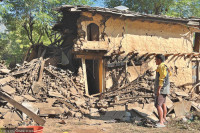Editorial
Breaching the barrier
Incidents of human and wildlife conflicts will exist, but we need to minimise such incidents to protect both species.
Of late, incidents involving human-wildlife conflict have been on the rise in Banke National Park's areas. And with every incident, there is always something worrisome; loss of property and livelihood often leads to retaliatory measures against wildlife. And the issue becomes particularly prickly when it involves the loss of human life. Human-wildlife conflict is on the rise due to increasing human pressure on available space, and this interaction often leads to increased conflicts. And belonging to a species that can influence the natural balance, the responsibility to set matters straight too falls upon us, humans.
There is no doubt that Nepal successfully deals with conserving wildlife, particularly the rhinos. And very recently, the government declared that there had been a surge in the tiger population, giving hope to conservationists fighting it to save it from extinction. While these successes need to be celebrated, there are glaring gaps that need to be plugged in areas related to conservation management in tandem with the local population. Providing compensation for the destruction of life and property, but perhaps what is equally necessary may be the prohibition orders or penalties for trespassing into protected territories.
Territories need to be marked and fenced, and any human habitation close to the wildlife reserve need to be vacated. This way, there would be less intrusion of humans to areas cordoned off and excluded primarily for wildlife preservation. These thorny issues may be easier said than done; nothing worthwhile can be achieved without local participation. The authorities need to win the trust of the locals and the locals, in turn, need to understand that overstepping the mark will not just endanger their own lives but may affect the entire conservation project itself.
Educating people on the issues of preserving natural reserves will go a long way in defining the course of preservation of wildlife. It is never pleasant when there is a loss of life on both sides. But usually, the compensation for the loss of human life involves a lot of bureaucratic wrangling. In a recent incident, the Post reported that members of families still haven’t been compensated. Grieving families should not be made to run around government offices seeking compensation. Instead, the authorities have to take it upon themselves to ensure that the funds are released early.
Besides releasing the funds at the earliest, there also needs to be a thorough investigation on the increasing incidents of tiger attacks. A particular fatality could be taken as a misadventure, but four deaths in three months in the same area call for the authorities’ immediate explanation. As humans continually seek to expand their habitat, encroaching into areas of protected reserves, the need for dealing with this issue at the highest level has become necessary now than ever. Incidents of conflict will exist in the future; our efforts must be directed towards minimising such incidents to protect both humans and wildlife.




 12.12°C Kathmandu
12.12°C Kathmandu












%20(1).jpg&w=300&height=200)

